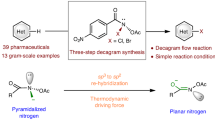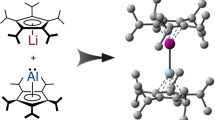Abstract
The chlorination of a bioactive compound can change its physiological properties and improve its pharmacokinetic and pharmacological profiles. It therefore has been an important strategy for drug discovery and development. However, the direct aromatic chlorination of complex bioactive molecules is too difficult to be practical. In fact, many functional groups such as hydroxyls, amines, amides or carboxylic acids may strongly restrain the reactivity of Cl+ by forming a halogen bond. Here we report a highly efficient aromatic chlorination of arenes that is catalysed by dimethyl sulfoxide with N-chlorosuccinimide as the chloro source. The mild conditions, easy-availability and stability of the catalyst and reagents, as well as good functional-group tolerance, showed the approach to be a versatile protocol for the late-stage aromatic chlorination of complex natural products, drugs and peptides. The multi-gram experiment and low-cost of N-chlorosuccinimide and dimethyl sulfoxide shows great potential for drug discovery and development in industrial applications.
This is a preview of subscription content, access via your institution
Access options
Access Nature and 54 other Nature Portfolio journals
Get Nature+, our best-value online-access subscription
$29.99 / 30 days
cancel any time
Subscribe to this journal
Receive 12 digital issues and online access to articles
$119.00 per year
only $9.92 per issue
Buy this article
- Purchase on Springer Link
- Instant access to full article PDF
Prices may be subject to local taxes which are calculated during checkout



Similar content being viewed by others
Data availability
Experimental procedures and characterization of the new compounds are available in the Supplementary Information. The data that support the plots within this paper and other findings of this study are available from the corresponding author on reasonable request.
References
Vogt, P. F. & Gerulis, J. J. in Ullmann’s Encyclopedia of Industrial Chemistry (Wiley-VCH, 2000); https://doi.org/10.1002/14356007.a02_037
Gribble, G. W. Natural organohalogens: a new frontier for medicinal agents. J. Chem. Educ. 81, 1441–1449 (2004).
Tang, M. L. & Bao, Z. Halogenated materials as organic semiconductors. Chem. Mater. 23, 446–455 (2011).
Auffinger, P., Hays, F. A., Westhof, E. & Ho, P. S. Halogen bonds in biological molecules. Proc. Natl Acad. Sci. USA 48, 16789–16794 (2004).
Hernandes, M. Z., Cavalcanti, S. M., Moreira, D. R., de Azevedo Junior, W. F. & Leite, A. C. Halogen atoms in the modern medicinal chemistry: hints for the drug design. Curr. Drug Targets 11, 303–314 (2010).
Sun, H., Keefer, C. E. & Scott, D. O. Systematic and pairwise analysis of the effects of aromatic halogenation and trifluoromethyl substitution on human liver microsomal clearance. Drug Metab. Lett. 5, 232–242 (2011).
Raju., T. N. K. The nobel chronicles. Lancet 355, 1022 (2000).
Cernak, T., Dykstra, K. D., Tyagarajan, S., Vachal, P. & Krska, S. W. The medicinal chemist’s toolbox for late stage functionalization of drug-like molecules. Chem. Soc. Rev. 45, 546–576 (2016).
Wencel-Delord, J. & Glorius, F. C–H Bond activation enables the rapid construction and late-stage diversification of functional molecules. Nat. Chem. 5, 369–375 (2013).
Yamaguchi, J., Yamaguchi, A. D. & Itami, K. C–H Bond functionalization: emerging synthetic tools for natural products and pharmaceuticals. Angew. Chem. Int. Ed. 51, 8960–9009 (2012).
Yamamoto, K. et al. Palladium-catalysed electrophilic aromatic C–H fluorination. Nature 554, 511–514 (2018).
Luca, L. D., Giacomelli, G. & Nieddu, G. A simple protocol for efficient N-chlorination of amides and carbamates. Synlett 2, 223–226 (2005).
Matsuo, J., Iida, D., Yamanaka, H. & Mukaiyama, T. N-tert-Butylbenzenesulfenamide-catalyzed oxidation of alcohols to the corresponding carbonyl compounds with N-chlorosuccinimide. Tetrahedron 59, 6739–6750 (2003).
Liu, W., Christenson, S. D., Standage, S. & Shen, B. Biosynthesis of the enediyne antitumor antibiotic C-1027. Science 297, 1170–1171 (2002).
Lin, S., Van Lanen, S. G. & Shen, B. Regiospecific chlorination of (S)-β-tyrosyl-S-carrier protein catalyzed by SgcC3 in the biosynthesis of the enediyne antitumor antibiotic C-1027. J. Am. Chem. Soc. 129, 12432–12438 (2007).
Dong, C. et al. Tryptophan 7-halogenase (PrnA) structure suggests a mechanism for regioselective chlorination. Science 309, 2216–2219 (2005).
Payne, J. T., Poor, C. B. & Lewis, J. C. Directed evolution of rebH for site-selective halogenation of large biologically active molecules. Angew. Chem. Int. Ed. 54, 4226–4230 (2015).
Frese, M. & Sewald, N. Enzymatic halogenation of tryptophan on a gram scale. Angew. Chem. Int. Ed. 54, 298–301 (2015).
Payne, J. T., Andorfer, M. C. & Lewis, J. C. Regioselective arene halogenation using the FAD-dependent halogenase rebH. Angew. Chem. Int. Ed. 52, 5271–5274 (2013).
Hering, T., Mîhldorf, B., Wolf, R. & Kçnig, B. Halogenase-inspired oxidative chlorination using flavin photocatalysis. Angew. Chem. Int. Ed. 55, 5342–5345 (2016).
Podgoršek, A., Zupan, M. & Iskra, J. Oxidative halogenation with “Green” oxidants: oxygen and hydrogen peroxide. Angew. Chem. Int. Ed. 48, 8424–8450 (2009).
Kovacic, P. & Sparks, A. K. Chlorination of aromatic compounds by antimony pentachloride. J. Am. Chem. Soc. 82, 5740–5743 (1960).
Prakash, G. K. S. et al. N-Halosuccinimide/BF3–H2O, efficient electrophilic halogenating systems for aromatics. J. Am. Chem. Soc. 126, 15770–15776 (2004).
Ben-Daniel, R., de Visser, S. P., Shaik, S. & Neumann, R. Electrophilic aromatic chlorination and haloperoxidation of chloride catalyzed by polyfluorinated alcohols: a new manifestation of template catalysis. J. Am. Chem. Soc. 125, 12116–12117 (2003).
Yang, L., Lu, Z. & Stahl, S. S. Regioselective copper-catalyzed chlorination and bromination of arenes with O2 as the oxidant. Chem. Commun. 42, 6460–6462 (2009).
Mo, F. et al. Gold-catalyzed halogenation of aromatics by N-halosuccinimides. Angew. Chem., Int. Ed. 49, 2028–2032 (2010).
Qiu, D., Mo, F., Zheng, Z., Zhang, Y. & Wang, J. Gold(iii)-catalyzed halogenation of aromatic boronates with N-halosuccinimides. Org. Lett. 12, 5474–5477 (2010).
Zhang, Y., Shibatomi, K. & Yamamoto, H. Lewis acid catalyzed highly selective halogenation of aromatic compounds. Synlett 18, 2837–2842 (2005).
Samanta, R. C. & Yamamoto, H. Selective halogenation using an aniline catalyst. Chem. Eur. J. 21, 11976–11979 (2015).
Do, H.-Q. & Daugulis, O. A simple base-mediated halogenation of acidic sp 2 C–H bonds under noncryogenic conditions. Org. Lett. 11, 421–423 (2009).
Kakiuchi, F. et al. Palladium-catalyzed aromatic C–H halogenation with hydrogen halides by means of electrochemical oxidation. J. Am. Chem. Soc. 131, 11310–11311 (2009).
Werf, A. & Selander, N. Para-selective halogenation of nitrosoarenes with copper(ii) halides. Org. Lett. 17, 6210–6213 (2015).
Maddox, S. M., Dinh, A. N., Armenta, F., Um, J. & Gustafson, J. L. The catalyst-controlled regiodivergent chlorination of phenols. Org. Lett. 18, 5476–5479 (2016).
Xiong, X. & Yeung, Y.-Y. Highly ortho-selective chlorination of anilines using a secondary ammonium salt organocatalyst. Angew. Chem. Int. Ed. 55, 16101–16105 (2016).
Xiong, X. & Yeung, Y.-Y. Ammonium salt-catalyzed highly practical ortho-selective monohalogenation and phenylselenation of phenols: scope and applications. ACS Catal. 8, 4033–4043 (2018).
Wang, M. et al. Story of an age-old reagent: an electrophilic chlorination of arenes and heterocycles by 1-chloro-1,2-benziodoxol-3-one. Org. Lett. 18, 1976–1979 (2016).
Maddox, S. M., Nalbandian, C. J., Smith, D. E. & Gustafson, J. L. A practical lewis base catalyzed electrophilic chlorination of arenes and heterocycles. Org. Lett. 17, 1042–1045 (2015).
Zhang, L. & Hu, X. Room temperature C(sp 2)–H oxidative chlorination via photoredox catalysis. Chem. Sci. 8, 7009–7013 (2017).
Tanemura, K., Suzuki, T., Nishida, Y., Satsumabayashi, K. & Horaguchi, T. Halogenation of aromatic compounds by N-chloro-, N-bromo-, and N-iodosuccinimide. Chem. Lett. 32, 932–933 (2003).
Hering, T. & Konig, B. Photocatalytic activation of N-chloro compounds for the chlorination of arenes. Tetrahedron 72, 7821–7825 (2016).
Zanka, A. & Kutota, A. Practical and efficient chlorination of deactivated anilines and anilides with NCS in 2-propanol. Synlett 12, 1984–1986 (1999).
Petrone, D. A., Ye, J. & Lautens, M. Modern transition-metal-catalyzed carbon–halogen bond formation. Chem. Rev. 116, 8003–8104 (2016).
Rodriguez, R. A. et al. Palau’chlor: a practical and reactive chlorinating reagent. J. Am. Chem. Soc. 136, 6908–6911 (2014).
Fosu, S. C., Hambira, C. M., Chen, A. D., Fuchs, J. R. & Nagib, D. A. Site-selective C–H functionalization of (hetero)arenes via transient, non-symmetric Iodanes. Chem 5, 417–428 (2018).
Denmark, S. E. & Beutner, G. L. Lewis base catalysis in organic synthesis. Angew. Chem. Int. Ed. 47, 1560–1638 (2008).
Gieuw, M. H., Ke, Z. & Yeung, Y.-Y. Lewis base catalyzed stereo- and regioselective bromocyclization. Chem. Rec. 17, 287–311 (2017).
Landry, M. L. & Burns, N. Z. Catalytic enantioselective dihalogenation in total synthesis. Acc. Chem. Res. 51, 1260–1271 (2018).
Snyder, S. A., Treitler, D. S. & Brucks, A. P. Halonium-induced cyclization reactions. Aldrichim. Acta 44, 27–40 (2011).
Denmark, S. E., Kuester, W. E. & Burk, M. T. Catalytic, asymmetric halofunctionalization of alkenes—a critical perspective. Angew. Chem. Int. Ed. 51, 10938–10953 (2012).
Martin, D., Weise, A. & Niclas, H. J. The solvent dimethyl sulfoxide. Angew. Chem. Int. Ed. 6, 318–334 (1967).
Wu, X.-F. & Natte, K. The applications of dimethyl sulfoxide as reagent in organic synthesis. Adv. Synth. Catal. 358, 336–352 (2016).
Song, S., Sun, X., Li, X., Yuan, Y. & Jiao, N. Efficient and practical oxidative bromination and iodination of arenes and heteroarenes with DMSO and hydrogen halide: a mild protocol for late-stage functionalization. Org. Lett. 17, 2886–2889 (2015).
Majetich, G., Hicks, R. & Reister, S. Electrophilic aromatic bromination using bromodimethylsulfonium bromide generated in situ. J. Org. Chem. 62, 4321–4326 (1997).
Ashikari, Y., Shimizu, A., Nokami, T. & Yoshida, J. Halogen and chalcogen cation pools stabilized by DMSO. Versatile reagents for alkene difunctionalization. J. Am. Chem. Soc. 135, 16070–16073 (2013).
Denmark, S. E. & Burk, M. T. Lewis base catalysis of bromo- and iodolactonization, and cycloetherification. Proc. Natl Acad. Sci. USA 107, 20655–20660 (2010).
Dewick, P. M. Medicinal Natural Products: A Biosynthetic Approach 3rd edn 161, 164–165 (John Wiley & Sons, 2009).
Lazar, C., Kluczyk, A., Kiyota, T. & Konishi, Y. Drug evolution concept in drug design: 1. Hybridization method. J. Med. Chem. 47, 6973–6982 (2004).
Tang, J. et al. Synthesis, characterization, and NF-κB pathway inhibition of 1-halogenated sinomenine derivatives. Chem. Nat. Comp. 48, 1031–1034 (2013).
Che, Z., Yu, X., Fan, L. & Xu, H. Insight into dihalogenation of E-ring of podophyllotoxins, and their acyloxyation derivatives at the C4 position as insecticidal agents. Bioorg. Med. Chem. Lett. 23, 5592–5598 (2013).
Boutureira, O. & Bernardes, G. J. L. Advances in chemical protein modification. Chem. Rev. 115, 2174–2195 (2015).
Taylor, R. D., MacCoss, M. & Lawson, A. D. G. Rings in drugs. J. Med. Chem. 57, 5845–5859 (2014).
Cresswell, A. J., Eey, S. T.-C. & Denmark, S. E. Catalytic, stereospecific syn-dichlorination of alkenes. Nat. Chem. 7, 146–152 (2015).
Samanta, R. C. & Yamamoto, H. Catalytic asymmetric bromocyclization of polyenes. J. Am. Chem. Soc. 139, 1460–1463 (2017).
Sakakura, A., Ukai, A. & Ishihara, K. Enantioselective halocyclization of polyprenoids induced by nucleophilic phosphoramidites. Nature 445, 900–903 (2007).
Seidl, F. J., Min, C., Lopez, J. A. & Burns, N. Z. Catalytic regio- and enantioselective haloazidation of allylic alcohols. J. Am. Chem. Soc. 140, 15646–15650 (2018).
Acknowledgements
Financial support from the National Natural Science Foundation of China (grant nos. 21602005, 21632001, 81821004), the National Basic Research Program of China (973 Program, grant no. 2015CB856600), the Drug Innovation Major Project (grant no. 2018ZX09711-001) and the Open Fund of State Key Laboratory of Pharmaceutical Biotechnology, Nanjing University, China (grant no. KF-GN-201906) are greatly appreciated.
Author information
Authors and Affiliations
Contributions
S.S. and N.J. conceived and designed the experiments. S.S. carried out most of the experiments. X.L. ran the calculations. S.S., X.L., J.W., W.W., Y.Z., L.A., Y.Z., X.S., X.Z. and N.J. analyzed data. S.S. and N.J. wrote the paper. N.J. directed the project.
Corresponding author
Ethics declarations
Competing interests
The authors declare no competing interests.
Additional information
Publisher’s note Springer Nature remains neutral with regard to jurisdictional claims in published maps and institutional affiliations.
Supplementary information
Supplementary Information
Supplementary Methods, Figs. 1–8, Tables 1–3 and references
Rights and permissions
About this article
Cite this article
Song, S., Li, X., Wei, J. et al. DMSO-catalysed late-stage chlorination of (hetero)arenes. Nat Catal 3, 107–115 (2020). https://doi.org/10.1038/s41929-019-0398-0
Received:
Accepted:
Published:
Issue Date:
DOI: https://doi.org/10.1038/s41929-019-0398-0
This article is cited by
-
Tandem catalysis enables chlorine-containing waste as chlorination reagents
Nature Chemistry (2024)
-
A concise and scalable chemoenzymatic synthesis of prostaglandins
Nature Communications (2024)
-
Discovery of N–X anomeric amides as electrophilic halogenation reagents
Nature Chemistry (2024)
-
Radical thioesterification via nickel-catalysed sensitized electron transfer
Nature Synthesis (2023)
-
Electrophilic Halogen Reagents-mediated Halogenation: Synthesis of Halogenated Dihydro-1,3-oxazine Derivatives
Chemical Research in Chinese Universities (2023)



